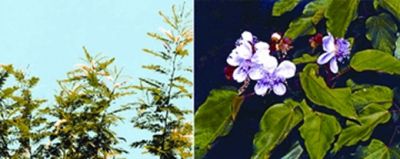Dye Plant
Dye Plant plants from which natural dyes are obtained to colour textiles, leather, food, paints, varnishes, ink, paper, wood, fur, medicine and cosmetics. There are about 150 such commercially important plants throughout the world. In Bangladesh, dyes are mostly used to colour cotton yarns, synthetic fibres and silk cloths. The most important textile dyes are obtained from a small spiny tree, Acacia catechu, locally known as Khoir tree, mostly growing naturally; but also cultivated in northeastern part of Bangladesh. The dye is extracted from the heartwood.

This dye is fast and is mostly used for various brown, khaki and drab colours; it is used for dyeing canvas, fishing nets and ropes. The popular orange dye obtained from the leaves of a shrubby plant, Lawsonia inermis, locally known as Mehedi, is used for dying hairs, eyebrows, fingernails and palms during ceremonials and festivals. turmeric, Curcuma longa, a herbaceous rhizomatous plant is a source of yellow colours for cloths, carpets, calico-printing, food stuffs and in preparation of curries.
The yellow or orange thistle-like flower heads of safflower, Carthamus tinctorius, are used for colouring food and cloths. Another minor dye yielding plant is Shephalika/Shephali or tree of sorrow, Nyctanthes arbor-tristis, the flower yield yellow colour. The seeds of the Annatto dye plant, Bixa orellana, is a source of a dye used to colour foodstuffs, wool, paints, varnish and soap. [Mostafa Kamal Pasha]
See also lac dye.
